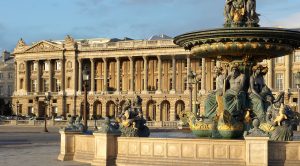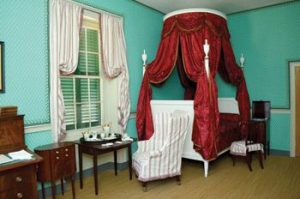Does Going There Matter?
Multi-prize-winning author T.J. Stiles (Custer’s Trials, The First Tycoon) recently posed this question on social media. “Do historians have to visit the sites in their books?” he asked. “I say no, no more than you have to have been alive in the times you write about.” Stiles contended that what is important is “personal experience,” which allows the writer to understand the feelings triggered in different situations, adding:
“I think the least necessary experience is going to a place where past events transpired. It can be helpful, or not — landscapes change, and often are well-documented. But a sense of the interior experience . . . that’s the tricky part.”

T.J. Stiles: “Don’t need to go there”
For fiction writing, a similar view was offered by Lawrence Block in his excellent primer on novel-writing (cleverly titled Writing the Novel), who insists that “with a decent atlas and a library of travel guides, it’s not all that difficult to do an acceptable job of faking a location.” Pointing to Yugoslavian settings he imagined, Block wrote:

Lawrence Block: OK to fake it
“I’m quite sure my Balkan settings bore little relationship to reality. Then again, I’m equally certain the overwhelming majority of my readers weren’t aware of the discrepancy between my version of Yugoslavia and the real one.”
Yes. And No.
Having written both history and historical fiction, I am firmly of two minds on this question. In novels, I have definitely faked settings. For The Lincoln Deception, I had to write a several scenes in and around a mansion on the southern shore of Lake Erie. Google Images supplied some photos of that shoreline, and, well, I made up the mansion.
Would it have been better to go to the lake and check it out? Maybe, if I could have found a suitable mansion to describe, and if I lived close to it. But once I was sure that the shoreline had no special characteristics, my experience of lakes and tours through mansions seemed good enough.
I felt differently for The Wilson Deception , which was set in France — mostly in Paris after World War I, with a look at the experience of American soldiers in the trenches. I spent two weeks in those locations, just getting comfortable with how the buildings from that period felt, with the food, with the language — all of which have changed since 1919, but are much closer to that reality than anything I see in suburban Maryland.
I was especially keen to get a close look at the Hotel de Crillon on Place de la Concorde, which was home to the American delegation to the Paris Peace Conference in 1919. Wouldn’t you know it? The hotel was closed for renovations for the year I worked on the novel, so I never did get inside.

Hotel de Crillon, Paris
What to do? In Paris, I went to view some other big old French buildings from the era and — with permission from Lawrence Block — faked it.
For historical works, though, I’m considerably more demanding, because readers should be. To write about the Constitutional Convention in 1787, I spent time at Independence Hall in Philadelphia. After all, the delegates spent four months in that room. I wanted to understand the organization of the tables and chairs, the acoustics, the light through the windows — even where the privy likely was.
When writing about James Madison, I spent a few days at his Montpelier estate, which helped most for his retirement years — especially being in the room where he spent the last two years of his life. The room opens onto the dining room, so he could take his meals at the door and converse with guests who were eating at the dining room table. You have to see it. . .

Room where James Madison spent his last two years, and died
And now that I’m working on a book about George Washington, I’ve visited all the important locations from his early life — starting with Mount Vernon, of course, but including his boyhood homes in Westmoreland County and in Fredericksburg, Barbados, Winchester, his lands on Bullskin Creek in “the west,” and multiple sites in Alexandria. For the rest of the book, I still need to get to Williamsburg, New York City, Philadelphia — my head hurts thinking about it.
To write history, there are only two choices for describing a setting: either go there and see it myself, or rely on (and disclose the source of) a contemporary description. If neither applies, then I don’t get to imagine the setting, but have to glide over details. Do descriptive details matter to the story? Sometimes. Sometimes not.
Stiles accurately states that the goal is to capture the feelings and spirit of the scene in your account, and that the writer brings his or her experience of life to that description. Two of my histories focus on trials — the impeachment trial of Andrew Johnson and Aaron Burr’s treason trial. Did my experience as a trial lawyer (even trying an impeachment before the U.S. Senate) help me portray those events? Absolutely.
But did it also help to be able to stand in the courtrooms where each of those essential contests took place. Absolutely.
The essential point for me is that if I have been to a setting and walked around in it, I gain confidence in my understanding of the moment, the people, the interests at stake, and the story I’m trying to capture. I may not be able to point to a specific sentence that is different because I traveled to a historic site, but that visit enhanced my confidence in the story and my ability to tell it. That’s worth going to some trouble for.
David McCullough (I think) pointed out that the writer of history has only a few windows on the past: the words left by the people who lived then, the implements they used and clothes they wore, the buildings they lived and worked in, and the landscapes they walked through. I want to look through all of those windows.
Each approach has it’s advantages. I suspect the answer depends more on the individual than anything else. What I do know is that, quite accidentally, I was sitting at a picnic table in direct view of the War Correspondents Memorial Arch, while reading the chapter of “The Lincoln Deception” which dealt with the main characters’ interactions with George Alfred Townsend. Lent an interesting spice to the situation as it dawned on me where I was at the time.